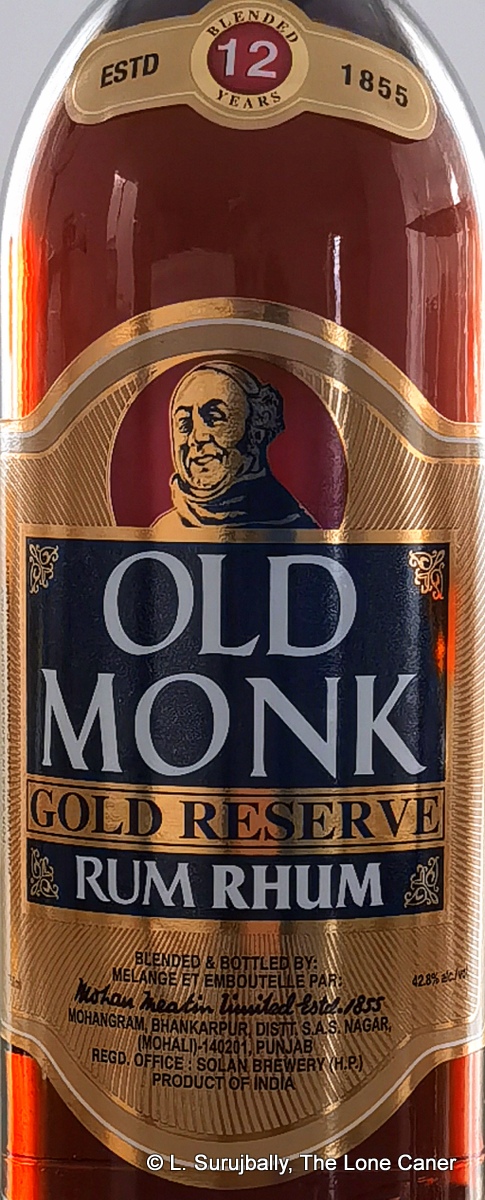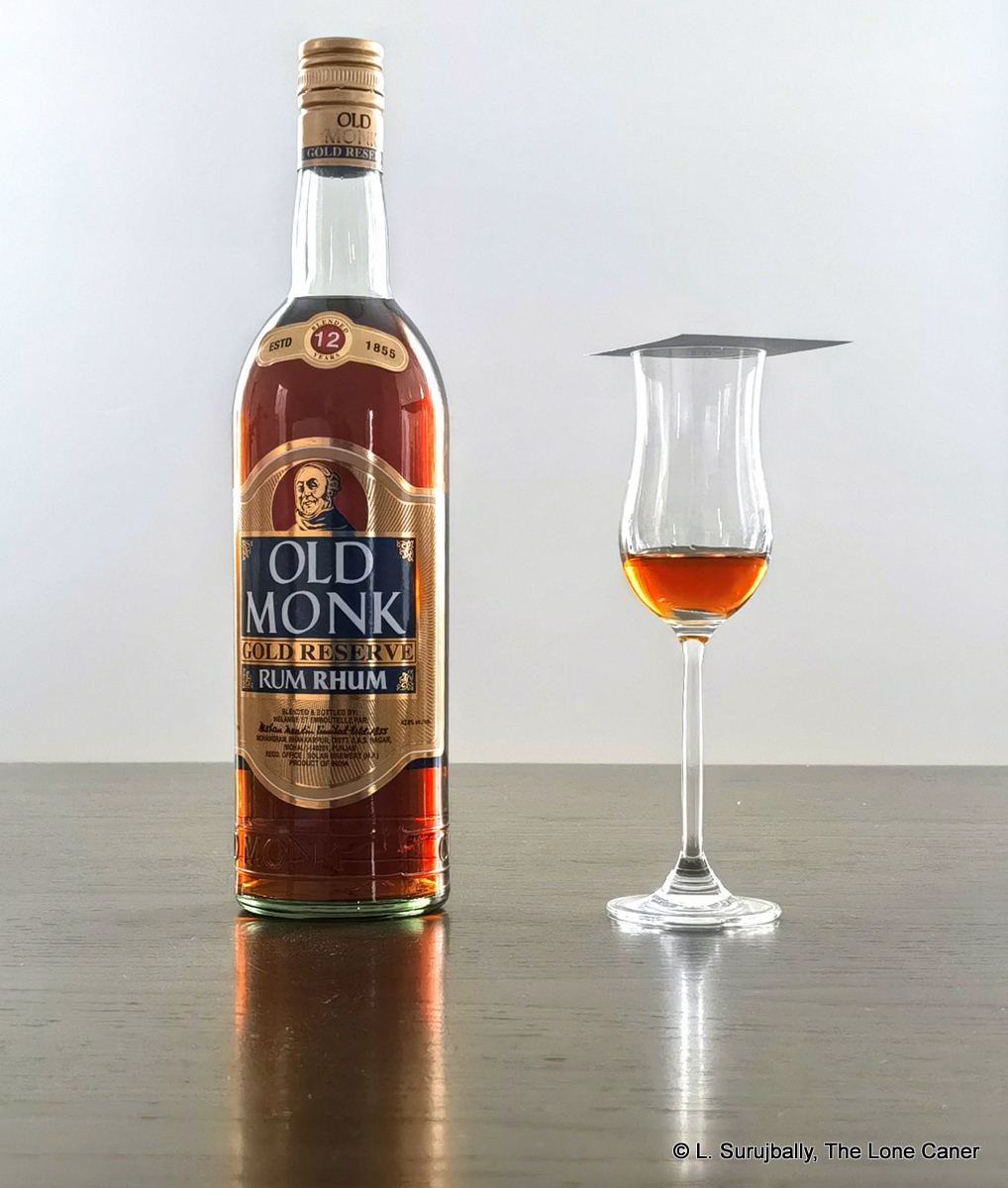Old Monk is almost a cultural institution in India, the way some distilleries’ brands, in their countries of origin – think J. Wray White Overproof in Jamaica, for example, or XM and El Dorado in Guyana, Angostura in Trinidad, AH Riise in Denmark, Stroh in Austria, Tanduay in the Philippines, Bundie in Australia…well you get the drift. The company that makes it, Mohan Meakin (previously Dyer Meakin), is among the first of the major distilleries set up in colonial India (in 1855), and I have covered it extensively in an enormously detailed post, and won’t rehash it here.
First issued in 1954, the Old Monk line of aged rums deliberately targeted a more affluent middle and upper class tippling audience. Previously — and still now, to a great extent — rum in India had been made as an additive-laden neutral spirit meant to make money on razor thin margins via massive sales to the poorer classes who could only afford a few annas. Predating the wave of premiumization that would crest a half century later, Mohan Meakin (the company was renamed 1966) pursued a strategy of ensuring it was available in luxury hotels and the military officers’ clubs. It rapidly became an institution in the whole country and the diaspora kept sales brisk wherever they emigrated, which is why I can find it all over the world today.
By 2024 the line of Old Monk had been expanded way beyond the original 7 YO blended XXX rum. Among others that were introduced (or withdrawn) over the years, there was the Matured Rum, Very Old Vatted, The Legend, Supreme, Gold Reserve Rum (of various ages), Orange Rum, White Rum and of course the grandaddy of them all, the XXX 7 YO vatted in the dimpled squat bottle, which is what most people have tried (and reviewed).
 The rum we are looking at today was manufactured in March 2023, is 12 years old, bottled at 42.8% and we know rather little about it except that it comes from molasses: that’s because, in a bewildering lack of marketing mojo, there does not appear to be a website for the company that is devoted to the product. For now, let’s call it a 12YO because we have nothing better to go on and that’s what they say it is (I have added a few comments below on other bits and pieces I dug up here and there).
The rum we are looking at today was manufactured in March 2023, is 12 years old, bottled at 42.8% and we know rather little about it except that it comes from molasses: that’s because, in a bewildering lack of marketing mojo, there does not appear to be a website for the company that is devoted to the product. For now, let’s call it a 12YO because we have nothing better to go on and that’s what they say it is (I have added a few comments below on other bits and pieces I dug up here and there).
Reviewers who have written about Old Monk — including myself — have almost always cast a jaundiced eye at the rums of the company, and suggested they have been adulterated, added to or otherwise messed with. Even with “clean” hydrometer tests, it’s hard not to come to that conclusion. And that’s because of the way it smells, and tastes.
Consider: the nose opens with an aroma of raw honeycombs, sweet peaches in syrup, cardamom, sandalwood, ripe bananas and a touch of brine and olives. There’s no citrus element here to balance things off and what fruits there are of the softer, less acidic kind, and after opening up one can sense some plastic, brown sugar, burnt caramel and smoking oil in a wok.
Tastewise, some of these peculiar notes persist, though much reduced. First of all it seems a little thick with sweetness, honey, cola and cardamom – it is this aspect that most often gives people pause and ask whether there’s an additive in there. Most of the softer points of the nose return for an encore, specifically the caramel, molasses, soft bananas and syrup, with some balance brought in by a touch of brine and olives. The finish is nothing special – short, dry, leather and smoke and some beeswax and honey. That’s about it.
Hydrometer test aside, the rum tastes reasonably okay and the balance is nice: it’s a step up from the regular 7 YO XXX. It displays just enough of an edge and is just different enough to excite curiosity from the tyro, or interest from a pro. I liked it enough to give it the score I do, but am unsure whether it works in the more common cocktails given that it marches to a slightly different beat. But for a 12 YO and for the quality it does have, it’s well worth just taking by itself and that’s how I’d suggest you try it.
(#1084)(84/100) ⭐⭐⭐⭐
Other notes
- A short video recap is here.
- Hydrometer tests out at 41.8% ABV, which works out to +/-4 g/L and within the margin of error.
- Additional comments on (lack of) production data: from various websites we can infer it is a vatted blend, aged in large oak vats or in standard oak casks (but not what kind) and then blended. One source mentions that a bit of the original Old Monk blend that’s more than 50 years old is always added in for consistency, but I chose to doubt that. Some say the source is jaggery, not actually molasses, which I can accept, though there is, as usual, no corroboration. What all this does is cast doubts on the age statement because we simply have no way of checking how truthful the company is about something when they say so little about anything.
- From MM Company bio: The question of who exactly the Old Monk was, remains a matter of some conjecture and there are three stories [1] it’s a stylized Benedictine monk such as originally inspired V.R. Mohan [2] it represents one of the founders of the company, H.G. Meakin himself, and is an homage to his influence, and [3] it represents a British monk who used to hang around the factory where the rums were made and aged, shadowing the master blender – his advice was so good that when Old Monk was first launched the name and bottle were based on him (this of course implies that aged rum was being made and sold by the company for years before 1954, but I simply have no proof of this and so cannot state it with assurance).
